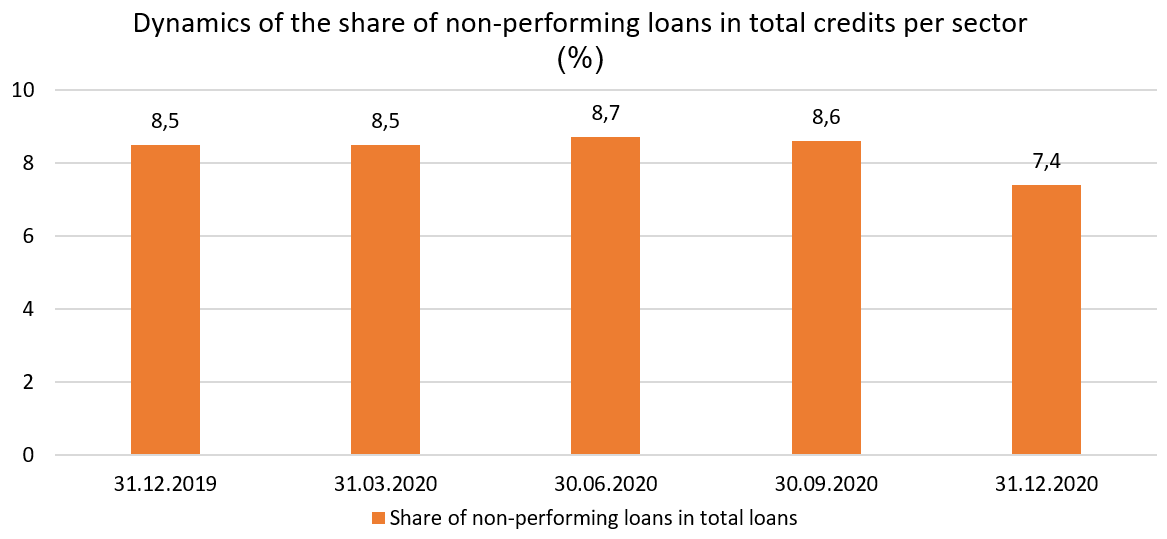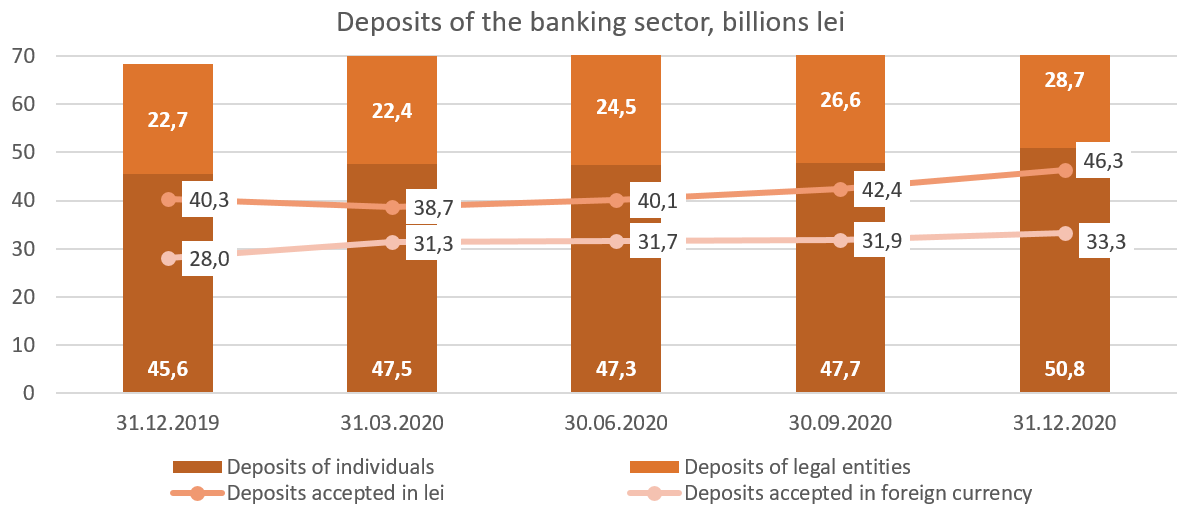During 2020, the National Bank of Moldova (NBM) continued the process of prudential supervision of banks in the Republic of Moldova, pursuing compliance with legal requirements, in order to prevent and limit the risks specific to banking. At the same time, for the period March - July 2020, taking into account the effects generated by the COVID-19 pandemic, the NBM adopted a series of measures in order to maintain the stability of the banking sector and encourage banks to work with borrowers to ensure optimal loan repayment conditions, in accordance with the powers conferred by law (link).
As of 31.12.2020, 11 banks licensed by the National Bank of Moldova were active in the Republic of Moldova. B.C. ENERGBANK S.A. was supervised under the early intervention regime applied on 11.01.2019, following the finding of a group of persons acting in concert who acquired and possessed a qualified holding in the bank's share capital in the amount of 52.55% without prior written approval and NBM. At the same time, part of the bank's management was replaced by temporary administrators appointed by the NBM. Subsequently, by the Decision of the Executive Board of the NBM from 09.10.2020, the term of appointment of the temporary administrators of B.C. "ENERGBANK" S.A. until 11.04.2021.
During 2020, there were no significant changes in the shareholding structure of licensed banks in the Republic of Moldova, except FinComBank S.A.
The year 2020 is characterized by the increase in assets, loans, own funds, deposits of individuals and deposits of legal entities. The banking sector has a high level of liquidity. At the same time, the quality of the loan portfolio has improved compared to the end of the previous year, and the profit obtained in 2020 registered a decrease compared to the similar period of the previous year.
The financial situation of the banking sector and compliance with prudential regulations
On 31.12.2020, the situation in the banking sector, based on the reports submitted by banks, registered the following trends:
Assets and liabilities
Total assets amounted to 103.9 billion lei, increasing during 2020 by 14.6% (13.2 billion lei).
In the structure of assets, the largest share belonged to the item in the balance sheet “Loans and advances at amortized cost”, which constituted 43.2% (44.9 billion lei), being decreasing by 2.0 percentage points (p.p.). The share of banks' investments in state securities and certificates of the National Bank (CBN) constituted 17.6% (18.3 billion lei), increasing by 4.5 p.p. The share of funds at the NBM was 21.7% (22.5 billion lei), decreasing by 1.4 p.p. The rest of the assets, which represent 17.5% (18.2 million lei) are maintained in other banks, in cash, tangible assets, intangible assets, etc. Their share decreased by 1.2 p.p.

The gross (prudential) balance of loans constituted 43.9% of total assets or 45.6 billion lei, increasing during the analyzed period by 13.1% (5.3 billion lei). At the same time, the volume of new loans granted during 2020 decreased by 1.58% compared to the same period of the previous year.
The largest increases in the loan portfolio were recorded in loans granted for the purchase / construction of real estate - by 26.3% (1.6 billion lei) and in loans granted to trade - by 11.7% (1.1 billion lei).
During the reference period, the share of non-performing loans (substandard, doubtful and compromised) in total loans decreased insignificantly by 1.1 p.p, amounting to 7.4% on 31.12.2020, the indicator ranging from 3.6% to 16.6%, depending on the bank.
At the same time, non-performing loans in absolute value decreased by 1.7% (58.7 million lei), amounting to 3.4 billion lei.
During the analyzed period, the share of expired loans in the total loans decreased insignificantly, from 4.8% to 4.5%.

At the same time, the trend of increasing the balance of deposits continued. According to prudential reports, they increased by 11.3 billion lei or 16.5% in the reference period, amounting to 79.6 billion lei (deposits of individuals accounted for 63.7% of total deposits, deposits of legal entities - 36.1 % and bank deposits - 0.2%). The largest impact on the increase in the balance of deposits had the increase of deposits of legal entities by 6.1 billion lei (26.8%) to 28.7 billion lei and deposits of individuals by 5.2 billion lei (11.3 %) up to 50.8 billion lei.
In total deposits, 58.2% returned to deposits in lei, their balance increased by 5.9 billion lei (14.8%), amounting to 46.3 billion lei on 31.12.2020. Foreign currency deposits accounted for 41.8% of total deposits, their balance increased during the reference period by 5.3 billion lei (18.9%), amounting to 33.3 billion lei. The increase was determined by the attraction of foreign currency deposits, the equivalent of 3.3 billion lei and, at the same time, by the exchange rate difference which amounted to +1.9 billion lei.

Revenues and profitability
As of 31.12.2020, the profit in the banking system amounted to 1.65 billion lei, decreasing by 27.0% (0.6 billion lei) compared to the similar period of the previous year.
-
The decrease in profit is largely determined by the increase in non-interest expenses by 27.0% (1.0 billion lei), mainly due to the increase in the depreciation of financial assets. At the same time, interest expenses decreased by 5.7% (0.08 billion lei), as a result of the decrease in the average rate on deposits in the national currency from 4.88% on 31.12.2019 to 3.96% at 31.12.2020 and respectively in foreign currency from 1.02% to 0.72%.
-
At the same time, there was an increase in non-interest income by 16.3% (0.48 billion lei), mainly due to the increase in foreign exchange gains by 0.32 billion lei (33.8%). Interest income decreased by 3.1% (0.1 billion lei) due to the decrease of the average rate on loans in national currency from 8.08% on 31.12.2019 to 7.66% on 31.12.2020 and in foreign currency from 5.09% to 4.90%. At the same time, the average interest rate on SS decreased from 6.4% to 5.01%.
Total revenues amounted to 7.8 billion lei, increasing compared to the end of the previous year by 0.34 billion lei (4.6%), of which interest income amounted to 56.0% (4.4 billion lei), and non-interest income - 44.0% (3.4 billion lei). At the same time, the total expenses constituted 6.2 billion lei, increasing compared to the previous year by 0.9 billion lei (18.3%). Interest expenses accounted for 21.4% (1.3 billion lei) of total expenses, and non-interest expenses - 78.6% (4.8 billion lei) of total expenses.
As of 31.12.2020, the return on assets and the return on capital constituted 1.7% and 9.6%, respectively, decreasing by 0.8 p.p. and 5.0 p.p., respectively, compared to the end of the previous year.
Compliance with prudential requirements
Throughout 2020, banks continued to maintain liquidity indicators at a high level.
Thus, the value of the long-term liquidity indicator (liquidity principle I) was 0.7 (limit ≤1), being at the same level compared to the end of 2019.
Current liquidity by sector (liquidity principle II) accounted for 50.6% (limit ≥20%), with more than half of the banking sector's assets being concentrated in liquid assets. The largest shares in liquid assets are held by NBM deposits - 42.9%, liquid securities - 31.5% and net interbank funds - 14.1%. During 2020, the share of deposits with the NBM decreased by 2.7 p.p., due to the decrease of the norm of required reserves held by banks from 42.5% to 32%, and the share of net interbank funds decreased by 3.1 p.p. At the same time, the share of liquid securities increased by 5.8 p.p. The share of cash remained practically at the same level as at the end of the previous year.
Principle III of liquidity, which represents the ratio between the adjusted actual liquidity and the required liquidity on each maturity band and which must not be less than 1 on each maturity band, has been respected by all banks.
On 01.10.2020, the Regulation on the liquidity requirements for banks came into force, according to which banks must maintain the indicator on the coverage of liquidity requirements, according to the following limits: 60% of the liquidity requirement - starting with October 1, 2020; 70% - starting with January 1, 2021; 80% - starting with January 1, 2022; 100% - starting with January 1, 2023. Currently all banks comply with the new provisions. The indicator given by sector constituted 317.8% (limit ≥ 60%) and varies from 151.0% to 988.3%.
According to the reports presented by the banks as of 31.12.2020, the rate of total own funds on the banking sector registered the value of 27.1%, increasing by 2.2 p.p. compared to the end of the previous year and varied at banks between 19.1% and 54.0%. All banks complied with both the regulated limit of the indicator (≥ 10%) and the capital requirements imposed following the monitoring and evaluation process.
As of 31.12.2020, total own funds amounted to 13.6 billion lei and increased by 19.3% (2.2 billion lei), mainly due to the reflection by banks of eligible profits for the year 2019 after the General Meeting of Shareholders.
As of 31.12.2020, banks complied with prudential indicators regarding large exposures and exposures to their affiliates.
At the same time, at a bank, the ratio between the indicator of the aggregate value of credit exposures to customers or a group of related customers, which is by size the first ten loan exposures and the total loan portfolio is higher than the prudential limit of 30%. As the bank complies with the additional own funds requirement for that surplus, exceeding the 30% limit does not constitute an infringement.
Development of the national legislative framework and its harmonization with EU legislation
During 2020, the National Bank of Moldova approved several normative acts in order to apply the provisions of Law no. 202/2017 on the activity of banks: Regulation on outsourcing the activities and operations of the bank (in new wording), Regulation on requirements to cover the need for liquidity for banks, Regulation on the disclosure requirements of banks, Regulation on the treatment of counterparty credit risk for banks, Regulation on the treatment of credit assessment adjustment risk for banks, Regulation on the supervision of banks on consolidated base, Regulation on Leverage for Banks.
Aligning the banking legislation of the Republic of Moldova with international standards by improving the quantitative and qualitative mechanisms of bank management contributes to promoting a secure and stable banking sector, increasing transparency, trust and attractiveness of the domestic banking sector for potential investors and creditors of banks, customers, including depositors, also to the development of new financial products and services.
























